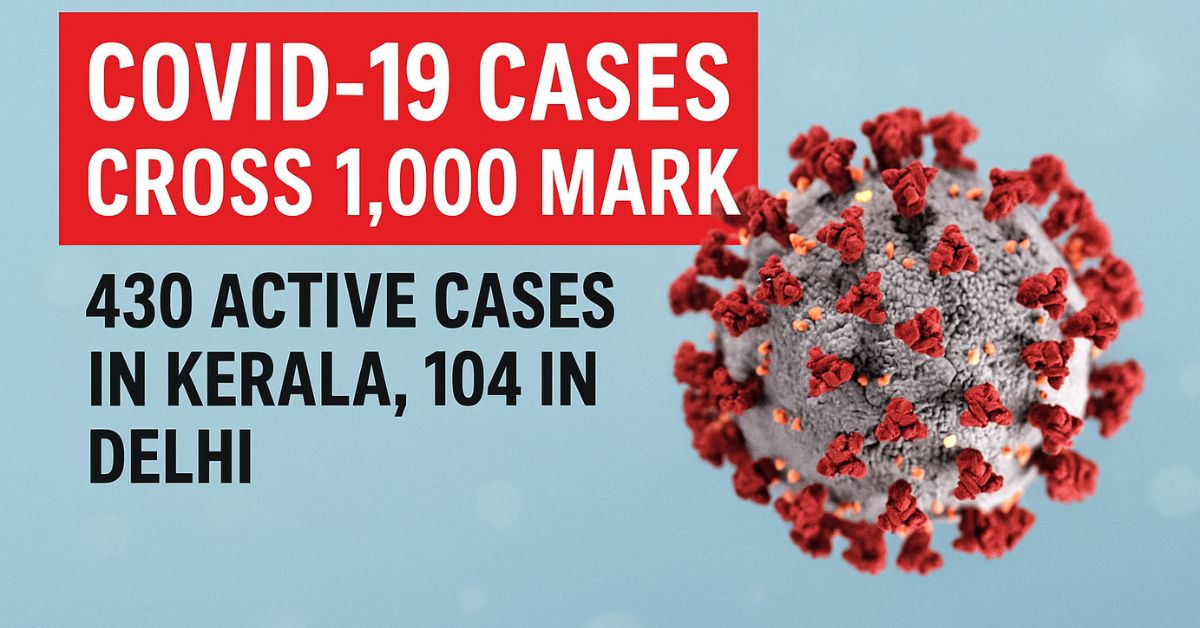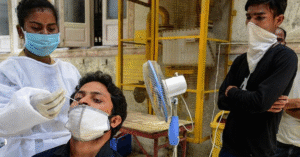COVID-19 Cases Cross 1,000 in India: Kerala, Delhi Among Top States in Fresh Spike
India witnesses a COVID-19 resurgence with over 1,000 active cases. Kerala tops with 430 cases, followed by Maharashtra and Delhi. Health advisories reissued amid new variants.
India has once again seen a significant rise in COVID-19 cases, with the nationwide tally of active infections crossing the 1,000 mark. As per the latest updates from health departments and official sources, Kerala, Maharashtra, and Delhi are the three states contributing the highest number of active cases.
This sudden spike has prompted several states to reintroduce mild preventive measures and issue health advisories, although authorities assure there is no cause for panic at this stage.
State-Wise Breakdown of COVID-19 Active Cases
The Ministry of Health and Family Welfare has confirmed a total of 1,009 active COVID-19 cases as of May 26, 2025. Here’s a detailed look at the most affected states:
Kerala: 430 Active Cases
Kerala remains the state with the highest number of active COVID-19 cases. The surge began earlier this week, with the state reporting over 335 new infections in just a few days.
Health Minister Veena George addressed the situation, urging the public to stay calm but alert. “We are closely monitoring the situation. All healthcare workers have been advised to wear masks in hospitals and isolation facilities. The rise is largely due to seasonal factors and increased mobility,” she said.
The state’s Health Department has also resumed genome sequencing to track possible mutations, especially after reports of subvariants such as NB.1.8.1 and LF.7 surfaced.
Delhi: 104 Active Cases
Delhi has also reported a steady rise in COVID-19 cases, now standing at 104 active cases, with 99 new cases detected since May 19. Chief Minister Rekha Gupta said the capital is “fully equipped” to handle the situation.
“We have ensured that hospitals have sufficient beds, oxygen supply, and ventilators. Our vaccination coverage remains high, and home isolation is working well for mild cases,” Gupta stated.
The Delhi government has reissued advisories encouraging the public to wear masks in public transport and crowded places, maintain social distancing, and avoid unnecessary travel.
Maharashtra: 209 Active Cases
Maharashtra, too, is witnessing a resurgence with 209 active cases. At least four COVID-19-related deaths have been reported, raising concerns among health experts.
Mumbai and Pune are among the worst-affected cities in the state. Local municipal corporations have resumed testing drives and are urging people to get tested if they show any symptoms such as fever, cough, or body aches.
State-Wise Breakdown of COVID-19 Active Cases
The Ministry of Health and Family Welfare has confirmed a total of 1,009 active COVID-19 cases as of May 26, 2025. Here’s a detailed look at the most affected states:
Kerala: 430 Active Cases
Kerala remains the state with the highest number of active COVID-19 cases. The surge began earlier this week, with the state reporting over 335 new infections in just a few days.
Health Minister Veena George addressed the situation, urging the public to stay calm but alert. “We are closely monitoring the situation. All healthcare workers have been advised to wear masks in hospitals and isolation facilities. The rise is largely due to seasonal factors and increased mobility,” she said.
The state’s Health Department has also resumed genome sequencing to track possible mutations, especially after reports of subvariants such as NB.1.8.1 and LF.7 surfaced.
Delhi: 104 Active Cases
Delhi has also reported a steady rise in COVID-19 cases, now standing at 104 active cases, with 99 new cases detected since May 19. Chief Minister Rekha Gupta said the capital is “fully equipped” to handle the situation.
“We have ensured that hospitals have sufficient beds, oxygen supply, and ventilators. Our vaccination coverage remains high, and home isolation is working well for mild cases,” Gupta stated.
The Delhi government has reissued advisories encouraging the public to wear masks in public transport and crowded places, maintain social distancing, and avoid unnecessary travel.
Maharashtra: 209 Active Cases
Maharashtra, too, is witnessing a resurgence with 209 active cases. At least four COVID-19-related deaths have been reported, raising concerns among health experts.
Mumbai and Pune are among the worst-affected cities in the state. Local municipal corporations have resumed testing drives and are urging people to get tested if they show any symptoms such as fever, cough, or body aches.
Rise in New COVID-19 Variants
One of the concerning developments is the emergence of new subvariants of COVID-19 in India. The NB.1.8.1 strain was detected in Tamil Nadu, while LF.7 was identified in Gujarat.
According to the World Health Organization (WHO), these are currently classified as Variants Under Monitoring (VUM). While they are not categorized as “Variants of Concern” yet, health authorities are closely tracking their transmissibility and potential impact.
As per data from the Indian SARS-CoV-2 Genomics Consortium (INSACOG), the dominant variant in the country remains JN.1, accounting for over 53% of cases. Other variants such as BA.2 and BA.5 continue to circulate, but with reduced severity.
Mild Symptoms and Home Isolation Encouraged
The good news is that most of the current cases are mild in nature and do not require hospitalization. The Indian Council of Medical Research (ICMR) stated that the virus is behaving in a less virulent form and most patients are recovering at home within 3-5 days.
Some of the commonly reported symptoms include:
- Low-grade fever
- Sore throat
- Mild cough
- Body aches
- Nasal congestion
The ICMR and AIIMS have jointly advised the public to follow home isolation protocols if they test positive, unless symptoms become severe.
Public Health Advisory: What You Should Do
Given the rising trend, the Ministry of Health has issued a general advisory to citizens across the country. Here are some of the key guidelines:
- Wear a mask in enclosed and crowded public spaces.
- Wash hands frequently with soap or use an alcohol-based sanitizer.
- Avoid large gatherings, especially indoors.
- Get tested if you exhibit any symptoms, even if mild.
- Follow home isolation protocols and consult a doctor if symptoms worsen.
- People with comorbidities or aged above 60 are advised to take extra precautions.
Vaccination remains the most effective weapon against COVID-19. Citizens are urged to check their booster dose status and get vaccinated if they haven’t completed their schedule.
Expert Opinion on the Current Situation
Dr. Randeep Guleria, former Director of AIIMS and a key member of India’s COVID-19 task force, remarked:
“This is not an alarming wave but rather a localized surge. We are seeing a pattern where every few months, some variants cause mild outbreaks. What’s essential now is surveillance, masking, and early treatment.”
He also noted that seasonal factors and declining public immunity could be contributing to the recent rise.
What Lies Ahead?
While India’s current COVID-19 situation is far from the alarming spikes of 2020 and 2021, the rise to over 1,000 active cases in a short span is a wake-up call for both the government and the public.
States with low case counts such as Uttar Pradesh (15), Karnataka (47), and West Bengal (12) are on high alert, monitoring travelers from affected areas and increasing testing at airports and railway stations.
Many schools and offices have begun reintroducing temperature checks, sanitization stations, and optional remote work policies.

